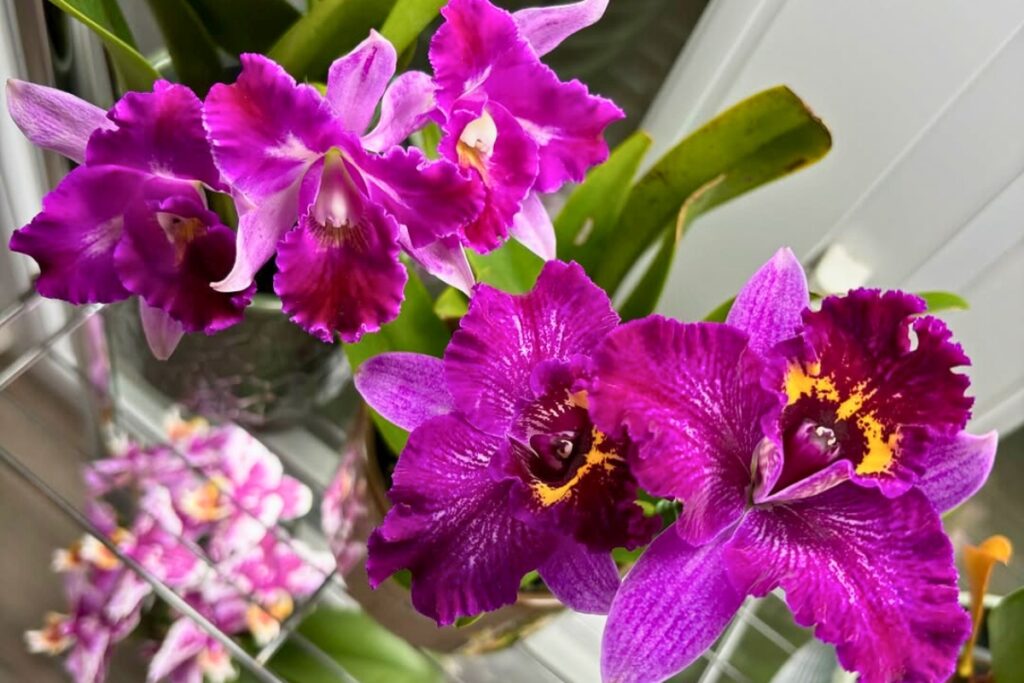You’re about to head out of town, but your prized Cattleya orchids need proper care while you’re away. Whether you’ll be gone for a weekend getaway or an extended vacation, these elegant plants require specific attention to maintain their health and blooming potential. With the right preparation and automated systems in place, you can enjoy your travels without worrying about your orchid collection. Let’s explore the essential steps to make sure your Cattleyas stay vibrant during your absence.

Contents
Preparing Your Cattleyas Before Departure
Before you transport your Cattleya orchids, you’ll need to make several preparations 3-5 days prior to departure. Water your plants thoroughly, allowing excess moisture to drain completely. Remove any dead leaves, spent blooms, and inspect for pests.
Secure loose stems with plant stakes and soft ties, ensuring flowers won’t get damaged during movement. If temperatures are below 55°F where you’re heading, wrap each pot in bubble wrap for insulation.
Place your orchids in stable containers or boxes with adequate ventilation. Don’t fertilize within a week of travel, as this can stress the plants and create unwanted growth during transport.
Setting Up Automated Watering Solutions
While preparing your orchids for travel addresses short-term care, you’ll need a reliable watering system for extended absences. Install a drip irrigation system with 1/4-inch tubing and adjustable emitters positioned 2-3 inches from each plant’s base.
Set your timer to water every 5-7 days during summer, or 8-10 days in winter. You’ll want to calibrate the flow rate to deliver 1-2 cups of water per plant, depending on pot size and humidity levels.
Add a moisture sensor that’ll automatically skip watering cycles when soil remains damp. This prevents root rot while ensuring your Cattleyas receive consistent hydration during your travels.
Managing Light and Temperature Controls
Since light and temperature fluctuations can stress traveling Cattleyas, you’ll need to establish reliable environmental controls. Install automated shade cloths or timers on your grow lights to maintain 12-14 hours of filtered brightness daily. Your orchids will thrive between 65-80°F during the day and 55-65°F at night.
Set up a small oscillating fan on a timer to run 4-6 hours daily, ensuring proper air circulation. Position your plants 3-4 feet from windows to avoid cold drafts or intense heat. If you’re gone longer than two weeks, consider installing a remote temperature monitor that’ll alert you to any concerning changes.
Creating the Right Humidity Environment
Once Cattleya orchids leave their native tropical habitat, they’ll need 50-70% humidity to stay healthy during travel. You can maintain these levels by placing your orchid in a clear plastic bag with damp sphagnum moss, leaving small air holes for ventilation.
If you’re traveling for more than three days, create a humidity tray by filling a shallow container with pebbles and water. Place your orchid’s pot above the water line, ensuring the roots don’t touch the liquid. For extended trips, consider using humidity beads or a portable humidifier set to 60%, positioning it 12 inches away from your plant’s foliage.
Enlisting Help From Plant Sitters and Support Systems
Before leaving your Cattleya orchids in someone else’s care, you’ll need to provide detailed instructions for their specific needs. Create a care sheet listing watering schedules, light requirements, and ideal temperature ranges between 65-80°F.
Select a trustworthy plant sitter who’s detail-oriented and available to check your orchids 2-3 times weekly. Show them how to test soil moisture with the wooden skewer method and recognize signs of trouble like yellow leaves or brown spots.
Consider setting up an automated support system with self-watering devices or humidity trays as backup. Install a Wi-Fi-enabled camera to monitor your plants remotely, allowing you to guide your sitter if issues arise.
